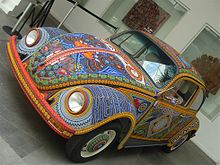Commons:Museo de Arte Popular
Introduction[edit]

The Museo de Arte Popular (Folk Art Museum) in the historic center of Mexico City was established in 2006 with the intention of becoming the main reference point for Mexican handcrafts and folk art. The Museum centers on its permanent collection representative of the various regions of the country. However, it also promotes temporary exhibits, workshops for children, artisans and the public in general as well as contests, seminars and other activities.
It is probably best known as the sponsor of the annual Monumental Alebrije parade, with floats containing very large colorful monsters parade in the center of Mexico City each October.
The Wikimedia partnership[edit]

The Museo de Arte Popular is the first Mexican museum to partner with Wikimedia's Galleries, Libraries, Archives and Museums program through Wikimedia México. Its first donation of images to Wikimedia Commons was authorized on 8 July 2011 and can be seen at Category:Images from the Museo de Arte Popular. Since then, it was invited members of Wikimedia México, prinicpally Thelmadatter and AlejandroLinaresGarcia to photograph its frequent events and have helped Wikipedians make contact with artisans in Mexico to develop articles and take photographs of workshops in Mexico City, Santa Clara del Cobre and Xochistlahuaca. In May 2012, it held Mexico's first ever edit-a-thon to work on Mexican handcraft articles in both Spanish and English. In 2013, 50+ photographs were uploaded from its archives into Commons.
In August 2015, the museum began a partnership with the Wiki Learning program of Tec de Monterrey to have students who need to complete community service hours (servicio social) work with them, creating content related to the museum's mission for Wikimedia projects. The first semester is dedicated to creating video and/or animation clips.
The Vochol[edit]

The Vochol is a Volkswagen (VW) Beetle that has been decorated with traditional Huichol (Wirrárika) beadwork from the center-west of Mexico. The name is a combination of “vocho”, a popular term for VW Beetles in Mexico, and “Huichol”, the common name of the Wirrárika indigenous group. The project was sponsored by agencies associated with the Museo de Arte Popular, Mexico City, the states of Jalisco and Nayarit and other public and private organizations. The Volkswagen was covered in 2,277,000 beads applied by eight artisans from two Huichol families in an exclusive design based on Huichol culture. Work on the car was finished in late 2010 and originally was scheduled to be auctioned off in 2011. However, the museum decided to keep the car and has since had the piece tour the United States, Canada and Europe to promote Mexican handcrafts and folk art.


